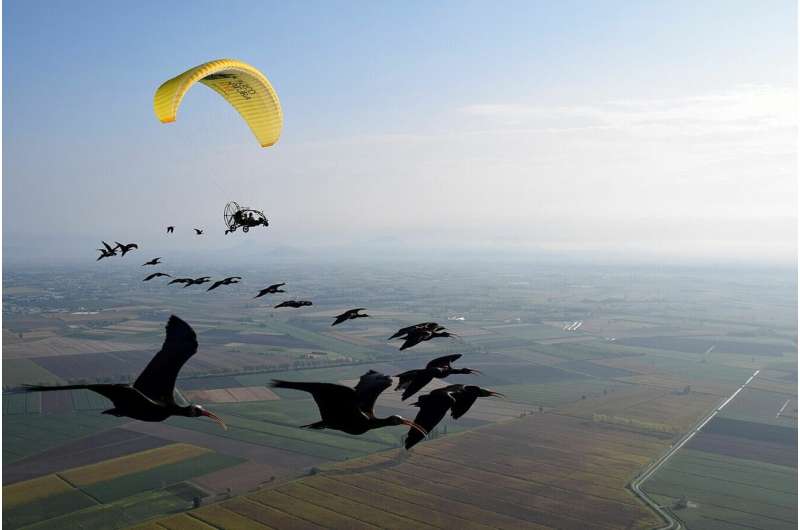This article has been reviewed according to Science X's editorial process and policies. Editors have highlighted the following attributes while ensuring the content's credibility:
fact-checked
peer-reviewed publication
trusted source
proofread
European northern bald ibis population well on the way to self-sustainability

A recently published paper in the journal Oryx evaluates the success of the established and well-known European reintroduction project for the northern bald ibis (Geronticus eremita).
Scientists from the Leibniz Institute for Zoo and Wildlife Research (Leibniz-IZW) and from the Austrian company Waldrappteam Conservation and Research evaluated demographic data from almost 400 individuals over 12 years and modeled future scenarios. The population has good survival and reproduction rates and the modeling also showed positive future survival probabilities, even assuming irregular losses due to catastrophes. The reintroduced population therefore has a good chance of long-term survival, the team concludes.
In 2002, a small team of researches and conservationists investigated the feasibility of reintroducing the northern bald ibis in Europe. This successful research project then led to a reintroduction project funded by the European LIFE-program in 2014. It was the first project to reintroduce a migratory species back into the wild and soon became popular for the rather spectacular images of their main method of translocation: the human led migration.
"Northern bald ibis chicks from the breeding program of zoological gardens form the basis for reintroduction. They are raised by human foster-parents and trained to follow a microlight airplane with human foster-parents as co-pilots. In this way, the juvenile birds are guided to a wintering area in autumn, where they are released," says Johannes Fritz, head and founder of Waldrappteam Conservation and Research.
Since the original project started more than 20 years ago, a large amount of data was collected on individual members of the population, which Sinah Drenske used for her Bachelor study: "We analyzed long-term demographic data of 384 individuals and assessed the success of the reintroduction alongside the impact of management measures. The comprehensive 12-year data set, spanning 2008–2019, also allowed us to carry out a population viability analysis to predict the future development of the population under different management scenarios," she says.
The Leibniz Institute for Zoo and Wildlife Research supported her research on the northern bald ibises. "In conservation biology, species restoration plays an increasingly important role in counteracting the ongoing dramatic decline of biodiversity," says Stephanie Kramer-Schadt, head of the Leibniz-IZW Department of Ecological Dynamics and holder of a professorial chair at Technische Universität Berlin.
"There is no general definition of translocation success, but any such definition should take into account population growth rate, population size, reproduction performance and the role and frequency of random catastrophic environmental events, such as adverse weather conditions. It is also important to evaluate the effect and efficacy of any management intervention."
The released population currently comprises about 200 individuals and has been successfully reproducing since 2011, with 250 young birds raised in the wild so far. First-year survival is 52% for wild born offspring and 73% for released juveniles, the survival for adults is 78%. These are good values compared to other release colonies and the last wild population in Morocco. Fecundity is particularly outstanding, with a mean of 2.15 fledglings per nest and a tendency to increase in all project's breeding areas. This result is particularly important for Fritz: "This reproductive performance is well above the levels of most other wild or released populations and we attribute this to the high quality of foraging habitats."
To assess the future prospects of the population, a population viability analysis was conducted. "The analysis showed that this population is well on the way to self-sustainability, but that further management measures are needed to reach this goal in the coming years," Drenske says. In addition to further release, management should include a reduction in human-caused mortality. This applies in particular to combating losses due to electrocution on unsecured power poles and illegal bird hunting in Italy.
The scientists also simulated scenarios of random catastrophic events with different frequencies and severities, all of which only had a small impact on the development of the population. "The results suggest that the current population can compensate catastrophes relatively well," says Drenske. The impact of stochastic events became very topical in November 2022, when a cyclone claimed the life of 27 ibises in just one night.
A more thorough assessment of the impact of climatic change will be important, as the population is likely to be affected by changing weather conditions. In particular, the beginning of autumn migration is delayed further and further, most likely because of the raised mean temperatures in late autumn. As a result, the birds are more likely to fail in their attempts to cross the Alps, presumably due to a lack of supporting thermals.
"Taking into account the effects of climate change when assessing and planning species conservation projects, will be of decisive importance for their success in the future," says Johannes Fritz.
More information: Sinah Drenske et al, On the road to self-sustainability: reintroduced migratory European northern bald ibises Geronticus eremita still need management interventions for population viability, Oryx (2023). DOI: 10.1017/S0030605322000540
Journal information: Oryx
Provided by Forschungsverbund Berlin e.V. (FVB)



















